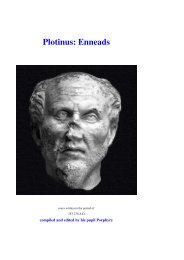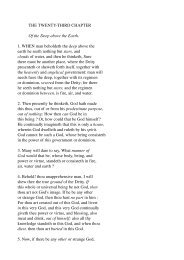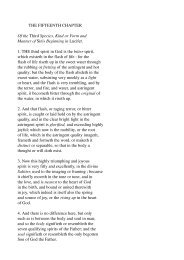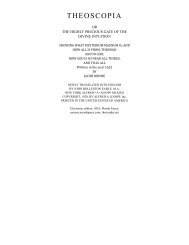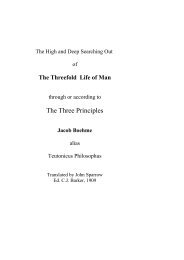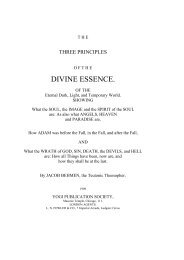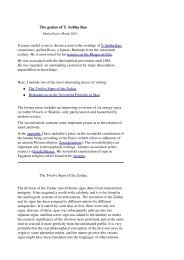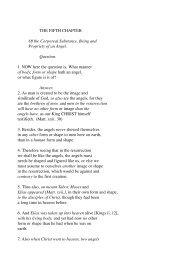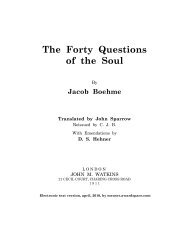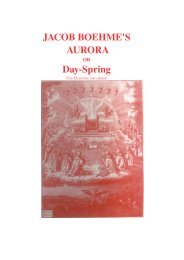Gerald Massey's Lectures - Society in evolution - Awardspace
Gerald Massey's Lectures - Society in evolution - Awardspace
Gerald Massey's Lectures - Society in evolution - Awardspace
You also want an ePaper? Increase the reach of your titles
YUMPU automatically turns print PDFs into web optimized ePapers that Google loves.
symbol of transformation. The pivot of the pantomime on which all turns is the pr<strong>in</strong>ciple<br />
of transformation. The transformation is from the lower world of the dead, the place of<br />
the mummies or masks--hence the giants, dwarfs, fairies, gnomes, bad spirits, and other<br />
types of the elemental powers, that were represented earlier than human spirits--to the<br />
daylight world of life, light, and liberty, now represented by fun, frolic, and lawlessness.<br />
Harlequ<strong>in</strong> is the potent transformer, who wields the wonder-work<strong>in</strong>g wand. With his<br />
mask down he is <strong>in</strong>visible; another proof that the masks represent the dead or the spirits.<br />
The f<strong>in</strong>al transformation scene represents heaven; the upper world of three. The mask,<br />
then, is the face of the dead, and the death-mask of the Siberian Shaman was preserved<br />
and hung up <strong>in</strong> his late residence, just above the place where he used to sit. In New<br />
Brita<strong>in</strong> the natives perform a religious ceremony called the "duk-duk," <strong>in</strong> which a spiritmessenger<br />
is represented as com<strong>in</strong>g <strong>in</strong> a mask. The women and children are prohibited<br />
from see<strong>in</strong>g the mask, and they must not say that it conceals any human be<strong>in</strong>g. If the<br />
performer allows the mask to slip off, they kill and make a ghost of him. Masks <strong>in</strong> animal<br />
forms and fashions represent the nature-powers or the Totemic and typical ancestors, but<br />
the human mask assuredly stands for a human spirit. And the endeavor to represent this<br />
can be traced from the rudest beg<strong>in</strong>n<strong>in</strong>gs. In some <strong>in</strong>stances the human face has been<br />
flayed from the bones, and transferred to form the mask of a fetish image. The aborig<strong>in</strong>es<br />
of Bolivia and Brazil used to take off the face and scalp from the skull, and reduce them<br />
to a m<strong>in</strong>iature mask of humanity, supposed to possess supernatural properties, and to<br />
furnish a most potent medic<strong>in</strong>e. The Maori, amongst others, learned to dessicate the head<br />
and preserve it <strong>in</strong> its own sk<strong>in</strong>, on the way to complete mummify<strong>in</strong>g of the corpse. Before<br />
the mummy could be embalmed entirely the skull was sacredly saved, and sometimes the<br />
flesh was imitated by coat<strong>in</strong>g it with a mask made of reddish matter. We are now for the<br />
first time <strong>in</strong> a position to apprehend the mean<strong>in</strong>g of the mummy-image, and to appreciate<br />
the motive of the Egyptians, who practised the art of embalm<strong>in</strong>g the dead until it was<br />
absolutely perfected.<br />
The Mummy or corpse was the dead mask which had been let fall from the face of life by<br />
the person who had transformed, and this was faithfully preserved, because it was the<br />
mortal likeness of the person who had transformed and become a spirit!<br />
In the primary stage and rudest conditions of the human race, the return<strong>in</strong>g ghost was<br />
naturally an object of terror and dread, the representative of all that was most fearsome <strong>in</strong><br />
external phenomena; not <strong>in</strong> the least likely to evoke, although it helped to ultimately<br />
evolve, a feel<strong>in</strong>g of reverence, which led to some k<strong>in</strong>d of worship; and a long road had to<br />
be traveled from the earliest period, when the ghost was besought and propitiated not to<br />
appear, up to the time when the bones of the dead were kept <strong>in</strong> the house or chest, and the<br />
mask or mummy was sacredly preserved on purpose to secure the presence of the ghost<br />
as a protection for the liv<strong>in</strong>g relatives--whence the lares and penates, and other forms of<br />
the household gods. Doubtless, it took a very long time to utilise the ghost, or fully make<br />
out its message to man. But that stage had been traveled by the Egyptians when they first<br />
come <strong>in</strong>to view. It is certa<strong>in</strong> that from the earliest monumental period, and, probably,<br />
ages before that, the Egyptians represented man to be what is termed an immortal spirit.<br />
The text of the 130th chapter of the "Book of the Dead" is said to have been discovered<br />
or re-discovered, <strong>in</strong> the reign of Housapti, the fifth k<strong>in</strong>g of the first dynasty, who lived<br />
more than 6000 years ago. At that time certa<strong>in</strong> portions of the sacred books were found as<br />
antiquities, of which the very tradition had been lost. And this is the chapter of "Vivify<strong>in</strong>g<br />
the soul for ever." The Egyptians were accustomed to set up two different images with<br />
the dead body <strong>in</strong> the tomb. One of these is the Shebti, or duplicative figure. This was one<br />
of their types of transformation; it represented the duplication of the mummy for another<br />
life, called that of the Second Breath. The other image was named the Ka, or second self.<br />
The 105th chapter of the Ritual is entitled the chapter of "Propitiat<strong>in</strong>g the Ka of a person<br />
<strong>in</strong> the div<strong>in</strong>e nether world;" and, <strong>in</strong> the pictorial illustration, the person is represented <strong>in</strong>



